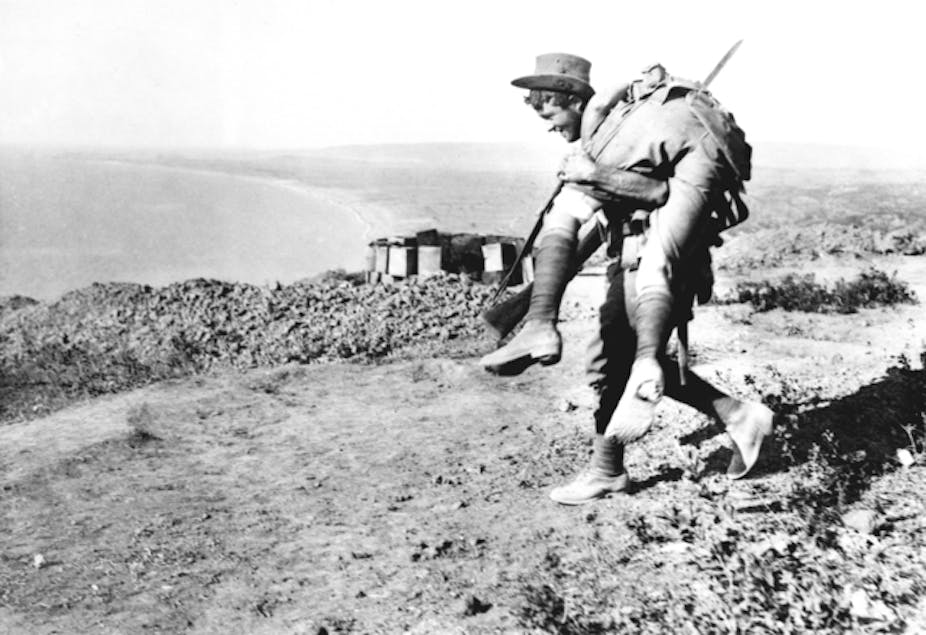In late 2007, a couple of months after our last HSC exam, one of my best friends punched me. In hindsight, I probably deserved it. We were 18, liberated from school and newcomers to alcohol.
To make a long and tedious story short, I said some mean things and he hit me. He wasn’t strong enough to do any damage and, thankfully, we were able to laugh about it the next day. Eight years later, we’re still very close.
I tell this story not to elicit sympathy, but to illustrate the often baffling nature of what Australians call “mateship”. As poet Henry Lawson once put it, a mate is someone who abuses you to your face and defends you behind your back.
Author and academic Nick Dyrenfurth’s new book, Mateship: A Very Australian History, explores both the contradictions and virtues of the term – what he calls Australia’s “genesis story”. Like the original, Dyrenfurth’s tale is part myth, part religion and part source of enduring conflict.
2015 is a difficult year in which to think critically about mateship and the national legend. Any discussion of the topic will inevitably exist in the shadow of the 100th anniversary of the landings at Gallipoli. Politicians will invoke it, critics will decry its politicisation.
Dyrenfurth’s book is particularly useful on this point. Complaining about the politicisation of national myths is like complaining about the commercialisation of Hollywood – irritating, yes, but it’s also kind of what they’re there for.
The book makes it clear that the term has always been contested. Another way of putting it is that Australia has different mateship traditions, depending on your politics.
In the late 19th century, unionist William Lane famously defined socialism as a “desire to be mates”. One hundred years on, progressives continue to promote Lane’s sentiment, if not his language. These left-wing advocates of mateship argue that it can only truly exist alongside economic dignity – that inequality renders it meaningless.

This idea persists within the union movement, but it’s also an important thread in Labor politics. When John Curtin called for equality of sacrifice during the Second World War, he evoked mateship. When introducing laws to undo the former Liberal government’s WorkChoices industrial relations reform, Julia Gillard accused John Howard of having hijacked Australian values.
Howard didn’t think he was hijacking anything. He had his own feelings about mateship. His ideas built on the conservative tradition, one traced back to the sacrifices and Imperial enthusiasm of the First World War. Instead of a commitment to economic equality, Howard defined the term in his own way – as a symbol of folk wisdom, of ordinary people’s common sense, a noble defence against the imposed guilt of urban elites.
The reason the term has survived this long is precisely because of its political flexibility. It appeals to both sides of politics. One of Dyrenfurth’s more incisive points is that the country’s most successful leaders have also been its most successful interpreters of the Australian legend.
This isn’t always a good thing. It certainly hasn’t been historically inclusive. Dyrenfurth’s book is admirably honest about its flaws and critics – and there’s been a lot of critics.
In 1976, historian Miriam Dixson linked mateship to a culture of sexism. She claimed that:
Men like women less in Australia than in any community I know.
Mateship was masculine and boozy, defined in opposition to the unwelcome presence of women.
Fellow historian Henry Reynolds tied the development of mateship to colonial atrocities. If fraternal loyalty grew in the bush, it also stood in the way of prosecuting murder. Magistrates found it almost impossible to crack the code of silence among a group of mates.

While Dyrenfurth suggests that mateship is evolving, it still maintains its original masculine musk. It might increasingly be used between men and women – Vance and Nettie Palmer, the 20th-century literary power couple, actually used “mate” as a lovers’ pet name – but it still overwhelmingly describes male friendship. This isn’t necessarily a bad thing, but it’s also shaky ground on which to built a truly national myth.
Another confusing aspect of the mateship legend is its persistent relationship with the bush. Australia is historically urbanised and rural settlers often embrace a form of Protestant self-reliance. As speechwriter Don Watson puts it:
Where we came from they were not inclined to sing about solidarity or even to call each other mate.
If a form of egalitarianism carried into the 20th century, then surely other institutions are equally responsible. The beach holds a prime place in the Australian imagination and is a space largely uninfected by wealth and status. So too most sports clubs (sailing doesn’t count as a sport). A truly modern version of the Australian legend should ideally take into account these realities of urban and coastal life.
Despite these minor quibbles, Mateship: A Very Australian History is a thoughtful and thorough contribution to the literature on Australian identity. Mateship might just be a word, one provoking scorn in some and patriotism in others, but it’s one that Australia hasn’t managed to shake. As Dyrenfurth shows us, that has to mean something.

